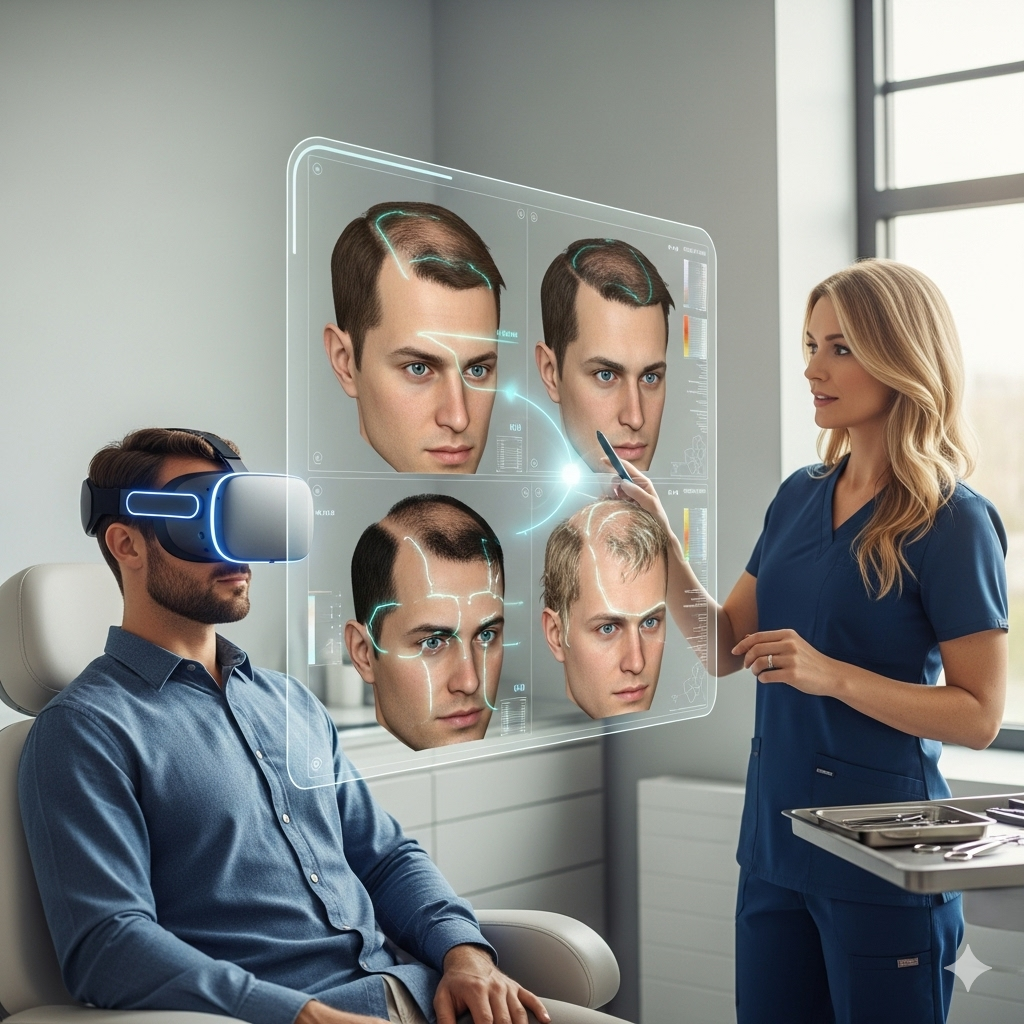Hair transplantation has advanced rapidly over the last decade, with improvements in surgical techniques, graft survival rates, and recovery times. But one of the most exciting innovations in recent years isn’t about the surgery itself—it’s about how we plan it. Virtual Reality (VR) and 3D simulation technology are transforming the way surgeons and patients approach hair restoration, offering unprecedented accuracy and confidence in the final outcome.
At ZMD Hair, we are committed to using the most advanced tools in the industry to deliver results that not only meet but exceed patient expectations. In this blog, we’ll explore how VR and 3D simulations are revolutionizing hair transplant planning, the benefits for patients, and what you can expect from the process.
What Is VR Hair Transplant Planning?
Virtual Reality in hair transplant planning uses specialized imaging systems to create a highly detailed 3D model of a patient’s head and hairline. This model allows both the surgeon and patient to visualize the potential results before a single graft is placed.
The process starts with high-resolution scans or photographs, which are processed through software that reconstructs a lifelike digital representation of your scalp. Surgeons can then simulate different hairline designs, densities, and angles—helping you see the transformation in real time.
Why This Technology Matters
Hair transplantation is as much an art as it is a science. Traditional planning methods relied on 2D sketches, mirror consultations, and the surgeon’s professional estimation. While skilled surgeons can deliver excellent results without VR, the technology removes much of the guesswork by showing exactly how different approaches might look on your unique facial structure.
Personalized Hairline Design
Every face is different, and so is every ideal hairline. VR technology allows for precise adjustments to hairline position, shape, and density, ensuring your restoration matches your natural proportions and personal style.
Patient Empowerment
One of the most common anxieties before a hair transplant is not knowing exactly how the results will look. VR simulations give patients a clear, visual preview, increasing confidence and satisfaction with the surgical plan.
Enhanced Surgical Precision
For the surgeon, VR models act as a visual blueprint during the procedure. This helps with planning graft placement, optimizing density in priority areas, and maintaining natural hair flow patterns.
How 3D Simulations Improve Results
3D simulation is more than just a planning tool—it’s a communication bridge between patient and surgeon. Here’s why it’s becoming a game-changer in hair restoration:
Accurate Density Mapping
The software can simulate different graft densities, showing how fuller or lighter coverage will look. This helps determine the best use of donor hair while managing expectations.
Realistic Angle and Direction Planning
Hair doesn’t grow straight out of the scalp; it has natural angles and curves. 3D models allow surgeons to plan these angles with precision, which is crucial for a natural appearance.
Scalable Adjustments
If a patient is considering multiple sessions, simulations can show how each phase will build on the last—providing a long-term vision of the restoration process.
What the VR Hair Transplant Planning Process Looks Like
At ZMD Hair, the integration of VR planning into your treatment journey is seamless and engaging:
- Initial Consultation: We assess your hair loss pattern, donor area quality, and overall goals.
- 3D Imaging: Specialized cameras or scanners create a complete 3D model of your head.
- Simulation Session: We adjust hairline shapes, densities, and coverage areas in the VR environment. You can compare side-by-side before-and-after projections.
- Finalizing the Plan: Once you approve the simulated look, the model serves as a surgical reference for graft placement.
- Execution & Follow-Up: The transplant is performed with the agreed-upon design, and follow-up visits ensure the results match the planned projection.
Who Benefits Most from VR and 3D Hair Transplant Planning?
While anyone undergoing a hair transplant can benefit from VR simulations, they are especially valuable for:
- First-time patients who want to visualize results before committing.
- Patients with limited donor hair, where precision in distribution is critical.
- Those seeking a major hairline redesign, such as lowering a high hairline or correcting asymmetry.
- Individuals considering multiple restoration sessions and wanting a roadmap of the process.
The Future of Hair Transplant Technology
The combination of VR and 3D simulations represents just one aspect of a broader trend toward tech-assisted hair restoration. As imaging and AI technologies continue to evolve, we may see even more advanced predictive models that incorporate hair texture, color, and even aging patterns into the planning process.
For patients, this means increasingly personalized treatments, greater control over the final outcome, and higher satisfaction rates. For surgeons, it means a powerful tool to refine artistry and precision.
Conclusion: Visualizing Your Best Hair Days Before They Happen
The integration of Virtual Reality and 3D simulations into hair transplant planning is transforming the patient experience. By offering a realistic preview of your results, this technology bridges the gap between expectation and outcome—reducing uncertainty and increasing confidence.
At ZMD Hair, we believe your hair restoration journey should be as transparent, personalized, and precise as possible. Our use of VR planning ensures that you’re not just imagining your results—you’re seeing them before the procedure begins.
Ready to see your future hairline today?
📞 Call ZMD Hair or visit zmdhair to schedule your personalized consultation. Let’s design your restoration plan with cutting-edge VR technology and make your hair goals a reality.




